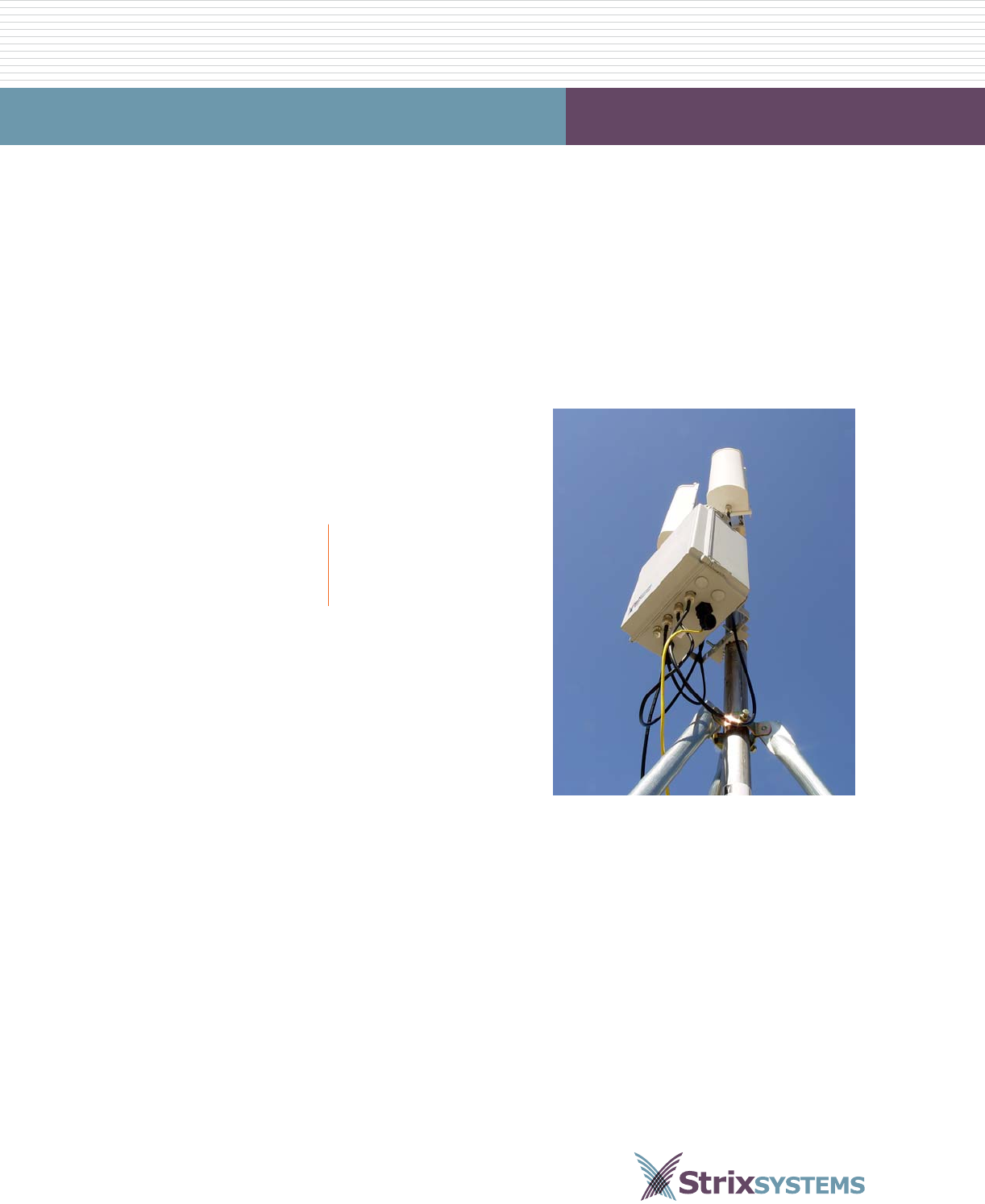Strix Systems ACCESS-ONE-O3 Strix Outdoor Wireless Ssytem User Manual ows hardware installation manual
Strix Systems, Inc. Strix Outdoor Wireless Ssytem ows hardware installation manual
Contents
- 1. Manual rev
- 2. Manaul
Manaul

ii
OWS Hardware Installation
Copyright Notice
Copyright © 2003 – 2005 Strix Systems, Inc. All rights reserved. This document may not be reproduced or
disclosed in whole or in part by any means without the written consent of Strix Systems, Inc. Access/One
Network is a registered trademark of Strix Systems, Inc. All other trademarks and brand names are marks of
their respective holders.
FCC Notice
The enclosed wireless network device complies with Part 15 of the FCC Rules. Operation is subject to the
following two conditions:
1. This device may not cause harmful interference.
2. This device must accept any interference received, including interference that may cause undesired
operation.
This wireless network device has been tested and found to comply with the limits for a Class B digital device,
pursuant to Part 15 of the FCC Rules. These limits are designed to provide reasonable protection against
harmful interference in a residential installation. This wireless network device generates, uses, and radiates
radio frequency energy and, if not installed and used in accordance with the instructions, may cause harmful
interference to radio communications. However, there is no guarantee that interference will not occur in a
particular installation. If this wireless network device does cause harmful interference to radio or television
reception, which can be determined by turning the wireless network device off and on, the user is
encouraged to try to correct the interference by one or more of the following measures:
◗Reorient or relocate the receiving antenna.
◗Increase the separation between the wireless network device and the affected receiver.
◗Connect the wireless network device into an outlet on a circuit different from that to which the
receiver is connected.
◗Consult the dealer or an experienced radio/TV technician for help.
Other Notices
Industry Canada Notice
This Class B digital apparatus complies with Canadian ICES-003.
Cet appareil numérique de la classe A est conforme à la norme NMB-003 du Canada.
VCCI Notice
This is a Class B wireless network device based on the standard of the Voluntary Control Council for
Interference from Information Technology Equipment (VCCI). If this wireless network device is used near a
radio or television receiver in a domestic environment, it may cause radio interference. Install and use the
wireless network device according to the instruction manual.
European Community (EC) Directives and Conformity
This wireless network device is in conformity with the Essential Requirements of R&TTE Directive 1999/5/EC
of the European Union.
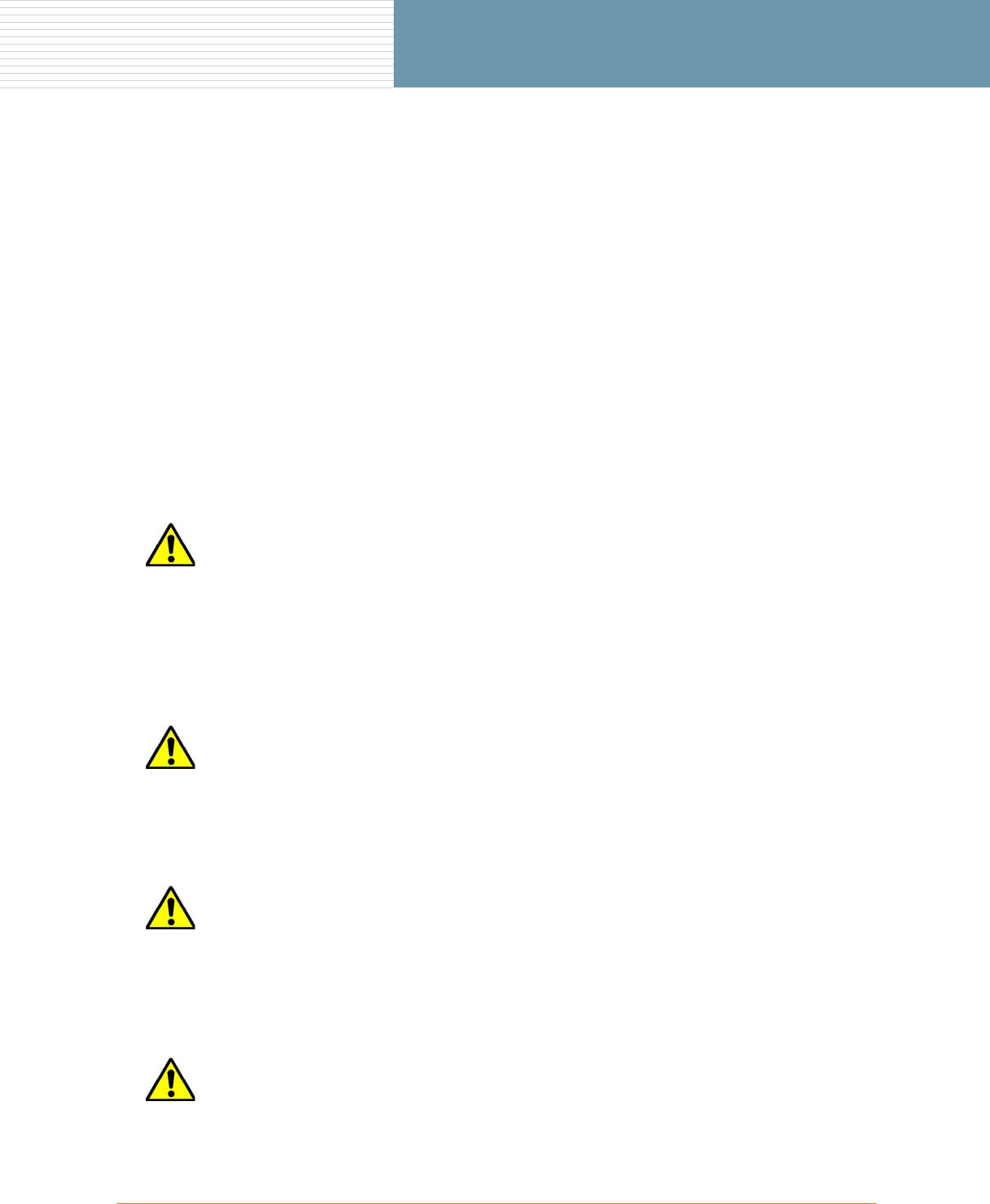
iii
OWS Hardware Installation
Non-Modification Statement
Unauthorized changes or modifications to Strix devices are not permitted. Modifications to Strix devices will
void the warranty and may violate FCC regulations.
RF Exposure Requirements
To ensure compliance with FCC RF exposure requirements, the antenna used for this wireless network device
must be installed to provide a separation distance of a minimum of 2 meters (6.56 feet) or more from all
persons, and must not be co-located or operated in conjunction with any other antenna or radio transmitter.
Installers and end-users must follow these installation instructions.
Safety Warnings
This unit must be installed by a trained professional installer only. Read all safety warning before
commencing an installation.
General Safety Warning
Electrical Power Warning
Lightning Activity Warning
Explosive Device Proximity Warning
You can be killed installing this device!
You can be killed if any antennas come near electrical power lines. Carefully read and
follow all instructions in this manual.
By performing these installation instructions, you may be exposed to hazardous
environments and high voltage. Use caution when installing the Strix OWS product.
This unit must be installed by a trained professional installer only. Read the installation
instructions before you connect the wireless network device to its power source.
Do not connect or disconnect cables during periods of lightning activity.
A surge protective device meeting IEC 61000-4-5, Level 4 or IEEE C 62.41 A3/B3
requirements must be used to prevent potential damage from very high surges (for example,
surges caused by lightning).
Do not operate your wireless network device near unshielded blasting caps or in an
explosive environment.
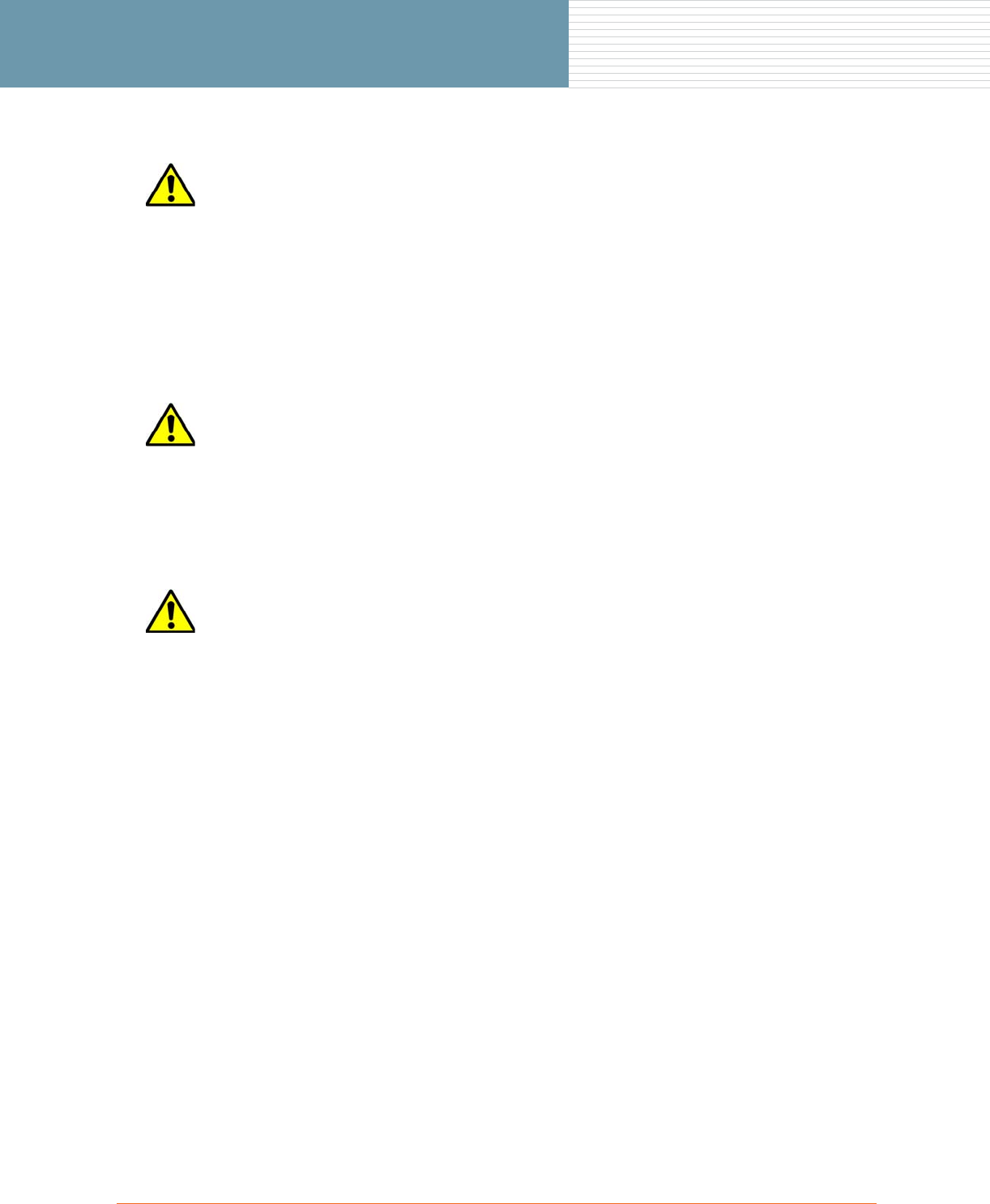
iv
OWS Hardware Installation
Antenna Placement Warning
Ground Warning
Battery Caution
Product Images
The images used in this document have been modified for clarity.
For additional information, please visit us at: http://www.strixsystems.com.
Do not locate any antenna near overhead power lines or other electric light or power
circuits, or where the antenna can come into contact with such circuits. When installing
antennas, take extreme care not to come into contact with such electrical circuits, as they
can cause serious injury or death.
For the correct installation and grounding of antennas, please refer to national and local
codes (for example, US:NFPA 70, National Electrical Code, Article 810; in Canada:
Canadian Electrical Code, Section 54).
You must ALWAYS install an external grounding wire. The ground connection must be
complete before connecting power to the OWS enclosure—a simple continuity check
between the enclosure and the ground termination point can confirm this. Grounding of the
OWS must comply with National Electrical Code (NEC) requirements, unless local codes in
your area take precedence over the NEC code.
This product contains a non-rechargeable, non-user-serviceable lithium ion battery. Exercise
caution to avoid shorting the terminals of this device.

Table of Contents v
OWS Hardware Installation
Table of Contents
Copyright Notice ....................................................................................................................................ii
FCC Notice ............................................................................................................................................ii
Other Notices ........................................................................................................................................ii
Safety Warnings ....................................................................................................................................iii
General Safety Warning ..................................................................................................................iii
Electrical Power Warning ...............................................................................................................iii
Lightning Activity Warning .............................................................................................................iii
Explosive Device Proximity Warning ..............................................................................................iii
Antenna Placement Warning .......................................................................................................... iv
Ground Warning ............................................................................................................................ iv
Battery Caution ............................................................................................................................... iv
Product Images ..................................................................................................................................... iv
OWS Field Installation ................................................................................................................. 1
Theory of Operation ...............................................................................................................................1
Important Safety Information ..................................................................................................................1
Planning Your Installation ......................................................................................................................2
Local Guidelines .............................................................................................................................2
Site Surveys .....................................................................................................................................2
Power Source ..................................................................................................................................2
OWS Enclosure Installation ....................................................................................................................3
Mounting the OWS on a Vertical Pole .............................................................................................3
Antenna Installation ...............................................................................................................................7
Recommended Antennas .................................................................................................................7
Notes About Antenna Installation ....................................................................................................8
Grounding the OWS Enclosure ..............................................................................................................9
Connecting the Power Cord .................................................................................................................10
Connecting the Ethernet Cable .............................................................................................................12
Powering Up the OWS .........................................................................................................................14
Powering Up from an AC Power Source ........................................................................................14
Powering Up from a DC Power Source ..........................................................................................14
OWS Product Specifications ................................................................................................................15
Index .......................................................................................................................................... 17

vi Table of Contents
OWS Hardware Installation
This page left intentionally blank

OWS Field Installation 1
OWS Hardware Installation
OWS Field Installation
This field installation manual provides instructions for installing the Strix OWS 2400 and OWS 3600 products
safely and is intended for trained technical professionals. You must read the “Safety Warnings” on page iii
before commencing with the installation.
Theory of Operation
The Strix Systems, Access/One® Network OWS 3600 provides up to 3 independent channels of 802.11b/g
support, and 3 independent channels of 802.11a support through its external connections. This configuration
allows the installer to separate the client 802.11b/g traffic from the backhaul traffic which is carried through
the 802.11a channels.
As shipped from the factory, the OWS 3600 is self-configuring and self-healing. In addition, multiple
configuration options are possible and the installer should refer to the Access/One® Network User's Guide
(part number 210-0008-01) for detailed information about these configurations.
Important Safety Information
The Federal Communications Commission (FCC) with its action in ET Docket 96-8 has adopted a safety
standard for human exposure to RF electromagnetic energy emitted by FCC certified equipment. All Strix
products, including the OWS, meet the uncontrolled environmental limits found in OET-65 and ANSI
C95.1, 1991. The proper operation of this wireless device, according to the instructions found in this
manual and the associated Access/One® Network software User’s Guide, result in user exposure that is
substantially below the FCC recommended limits.
The following are guidelines to ensure safe operation of the Strix OWS product:
◗Do not touch or move the antenna(s) while the unit is transmitting or receiving.
◗Do not hold any component containing a radio such that the antenna is very close to or touching any
exposed parts of the body—especially the face or eyes—while transmitting.
◗Do not operate the OWS or attempt to transmit data unless the antenna is connected, otherwise the
wireless module(s) may be damaged.
◗Usage in specific environments:
◗Do not operate a portable transmitter near unshielded blasting caps or in an explosive
environment, unless it is a type especially qualified for such use.
◗The use of wireless devices in hazardous locations is limited to the constraints posed by the safety
directors or such environments.
◗The use of wireless devices on airplanes is governed by the Federal Aviation Administration (FAA).
◗The use of wireless devices in hospitals is restricted to the limits set forth by each hospital.
◗The Strix OWS must only be used with Strix-approved components and antennas.

2OWS Field Installation
OWS Hardware Installation
Planning Your Installation
To ensure safe and durable wiring, the installation of the Strix OWS must follow the appropriate electrical and
building codes. Observe the National Electrical Code (NEC) requirements, unless local codes in your area
take precedence over the NEC code.
Local Guidelines
The Strix OWS is a radio device and therefore susceptible to interference that can reduce throughput and
range. Follow these simple guidelines to optimize product performance:
◗Install the OWS in an area where trees, buildings, and large steel structures do not obstruct radio
signals to and from the antenna(s). Direct line-of-sight operation is always best.
◗Install the OWS away from microwave ovens or other devices operating in the 2.4 GHz range.
◗Install the OWS away from other possible source of 2.4 GHz WLAN interference, such as cordless
phones, home surveillance equipment, frequency-hopping (FHSS) and DSSS Local Area Network
transceivers (non-802.11b), electronic news gathering video links, radars, amateur radios, land mobile
radio services, local government sties (for example, law enforcement), fixed microwave services, local
TV transmission, and private fixed point transmitters.
Site Surveys
Due to variations in product configuration, placement, and the physical environment, each installation is
unique. Before installing the Strix OWS, we recommend that you perform a site survey to determine the
optimum placement of the product to achieve the best possible range, coverage and network performance.
Consider the following points:
◗Data Rates—Sensitivity and range are inversely proportional to data bit rates. The maximum wireless
range is achieved at the lowest data rate. A decrease in receiver threshold sensitivity occurs as wireless
data increases.
◗Antenna Type and Placement—Using the correct antenna configuration is a critical factor when trying
to maximize wireless range. As a general rule, the range increases in proportion to the antenna height
and gain.
◗Physical Environment—Clear or open areas offer better wireless coverage than closed or filled areas.
The less cluttered the operating environment, the greater the range.
◗Obstructions—A physical obstruction, such as a building or tree, can block or hinder wireless
services. Avoid placing antennas in locations where there is an obstruction between the sending and
receiving antennas.
◗Building Materials—Wireless penetration is influenced by the building materials used in construction.
For example, drywall construction permits greater range than concrete blocks. Steel and alloy
materials can be a barrier to wireless signals.
◗Diversity—The Strix OWS supports RX diversity, which requires two antennas.
Power Source
The Strix OWS supports both AC and DC input power.
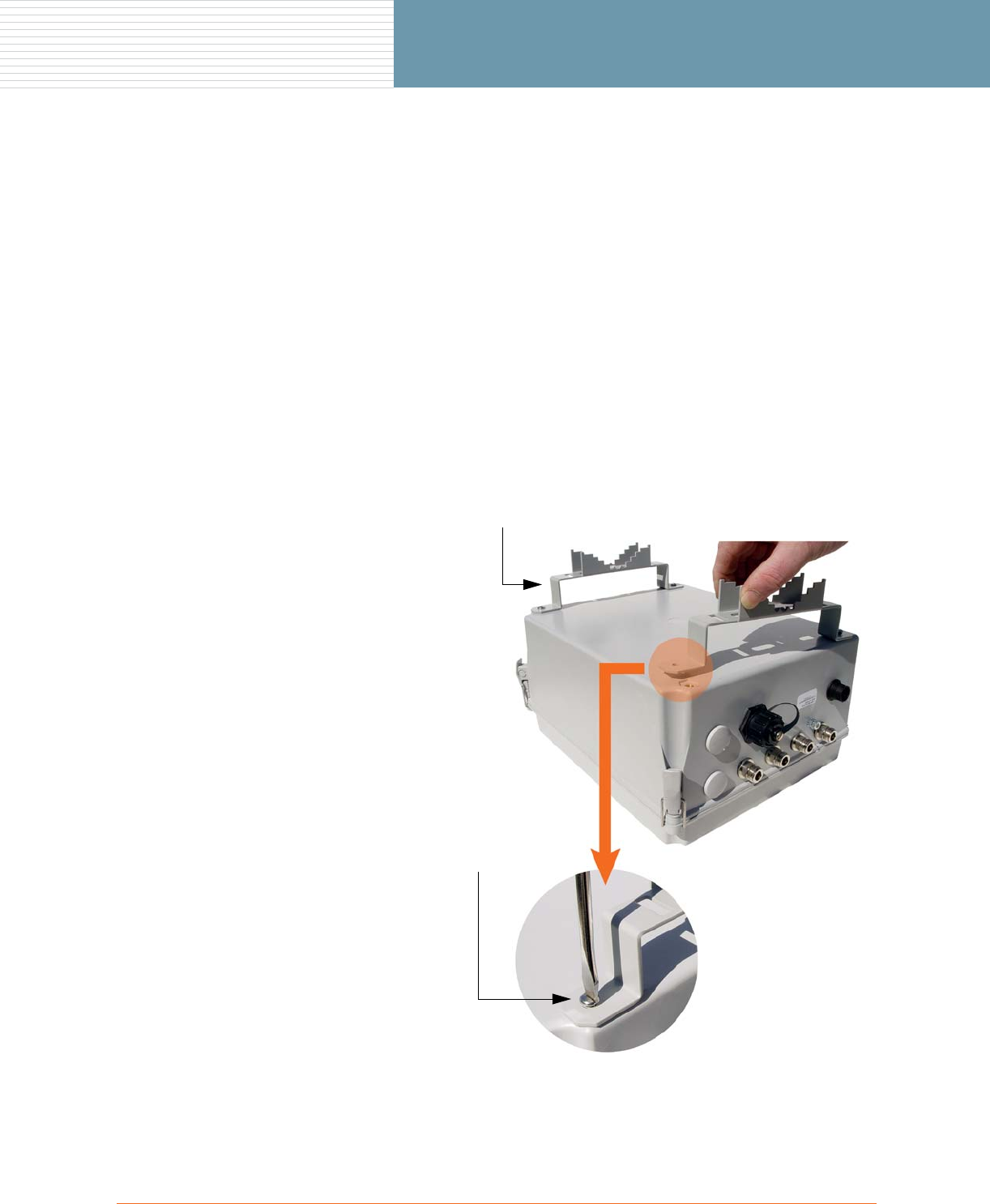
OWS Field Installation 3
OWS Hardware Installation
OWS Enclosure Installation
This section provides instructions for mounting the OWS enclosure.
Mounting the OWS on a Vertical Pole
Parts Required
◗OWS enclosure
◗Pole
◗2 vertical mounting brackets
◗4 screws, for attaching the mounting brackets to the OWS enclosure
◗2 U-bolt assemblies, for mounting the OWS enclosure to a standard 1 7/8 inch diameter steel pole
◗2 straps, for mounting the OWS enclosure to a pole with a diameter greater than 1 7/8 inches
Tools Required
◗Flat blade screwdriver ◗7/16 inch nut wrench
1. Attach the vertical mounting
brackets (2) to the OWS
enclosure.
2. Secure the vertical mounting
brackets to the OWS enclosure
with the four screws (2 for each
bracket).
Tighten all four screws to 10–12
lbf.ft (1.38–1.66 kgf.m).
Screws (x4)
Mounting Brackets (x2)
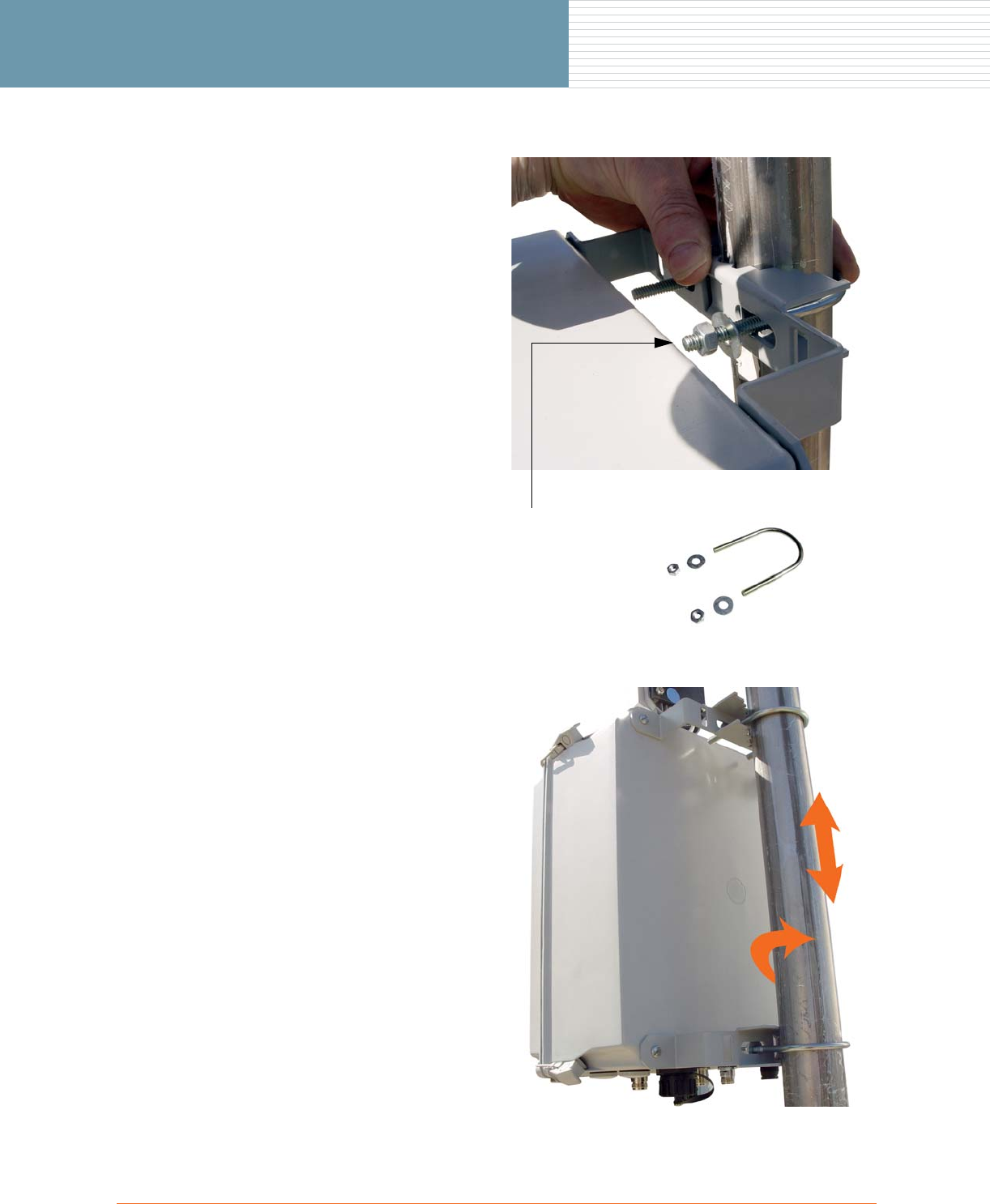
4OWS Field Installation
OWS Hardware Installation
3. For a standard 1 7/8 inch
diameter steel pole installation,
use the 2 U-bolt assemblies to
attach the enclosure to the pole
via the vertical mounting
brackets—finger tighten only.
If installing the OWS on a wider
pole (for example, a utility pole),
go directly to Step 7—skip Steps
3 through 6.
Tip: You may find it easier to
loosely attach the U-bolts to the
brackets, then slide the
completed enclosure assembly
over the pole (instead of holding
the enclosure against the pole
and attaching each U-bolt
separately).
4. Adjust the OWS enclosure to the
desired position on the pole (up
and down or rotational).
U-Bolt Assembly (x2)
Includes:
◗U-bolt
◗Washers (2)
◗Nuts (2)
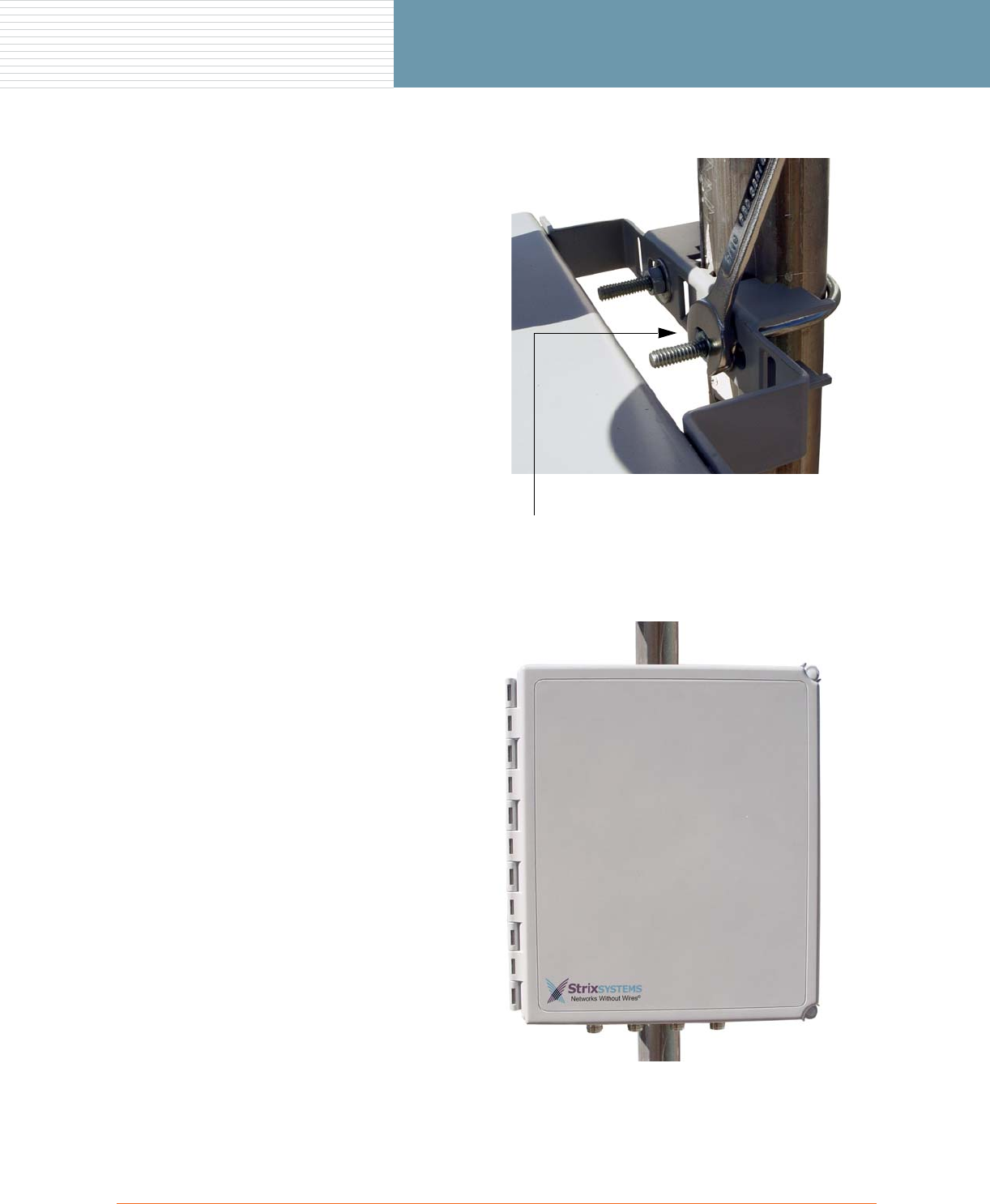
OWS Field Installation 5
OWS Hardware Installation
5. Use a 7/16 inch nut wrench to
tighten the U-bolts (4 nuts) and
secure the OWS enclosure in
place.
Tighten all four nuts to 10–12
lbf.ft (1.38–1.66 kgf.m).
When tightening the U-bolts,
ensure that the bolts are not
twisted—the ends of each U-bolt
should be protruding through the
bracket evenly (the same
distance).
6. Check that the U-bolts are tight
and that the OWS enclosure is
securely anchored to the pole.
Tighten (4 places)
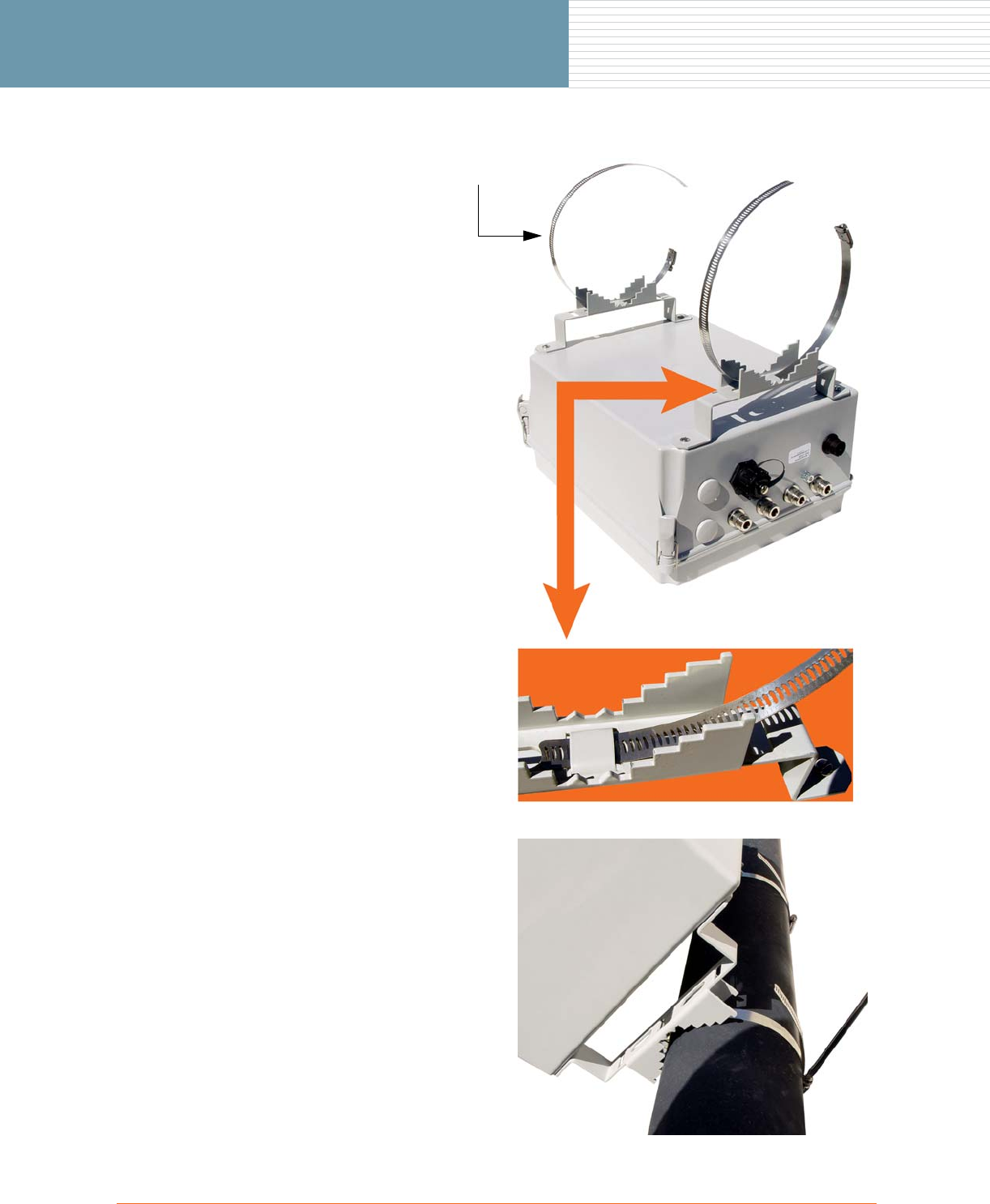
6OWS Field Installation
OWS Hardware Installation
7. For poles wider than 1 7/8 inch
diameter, use two straps (hose
clamps)—not provided. Feed one
strap through each of the vertical
mounting brackets.
Recommended straps:
Type 301 SS with Type 305 SS
screw, 3.125 x 6 inches,
available from McMaster-Carr
(part number 54155K36).
8. Loosely attach the OWS
enclosure to the pole with the 2
straps.
Adjust the enclosure to the
desired position on the pole (up
and down or rotational). Use a
flat blade screwdriver or 5/16
inch nut driver to tighten both
straps to 10–12 lbf.ft (1.38–1.66
kgf.m).
Straps (x2)
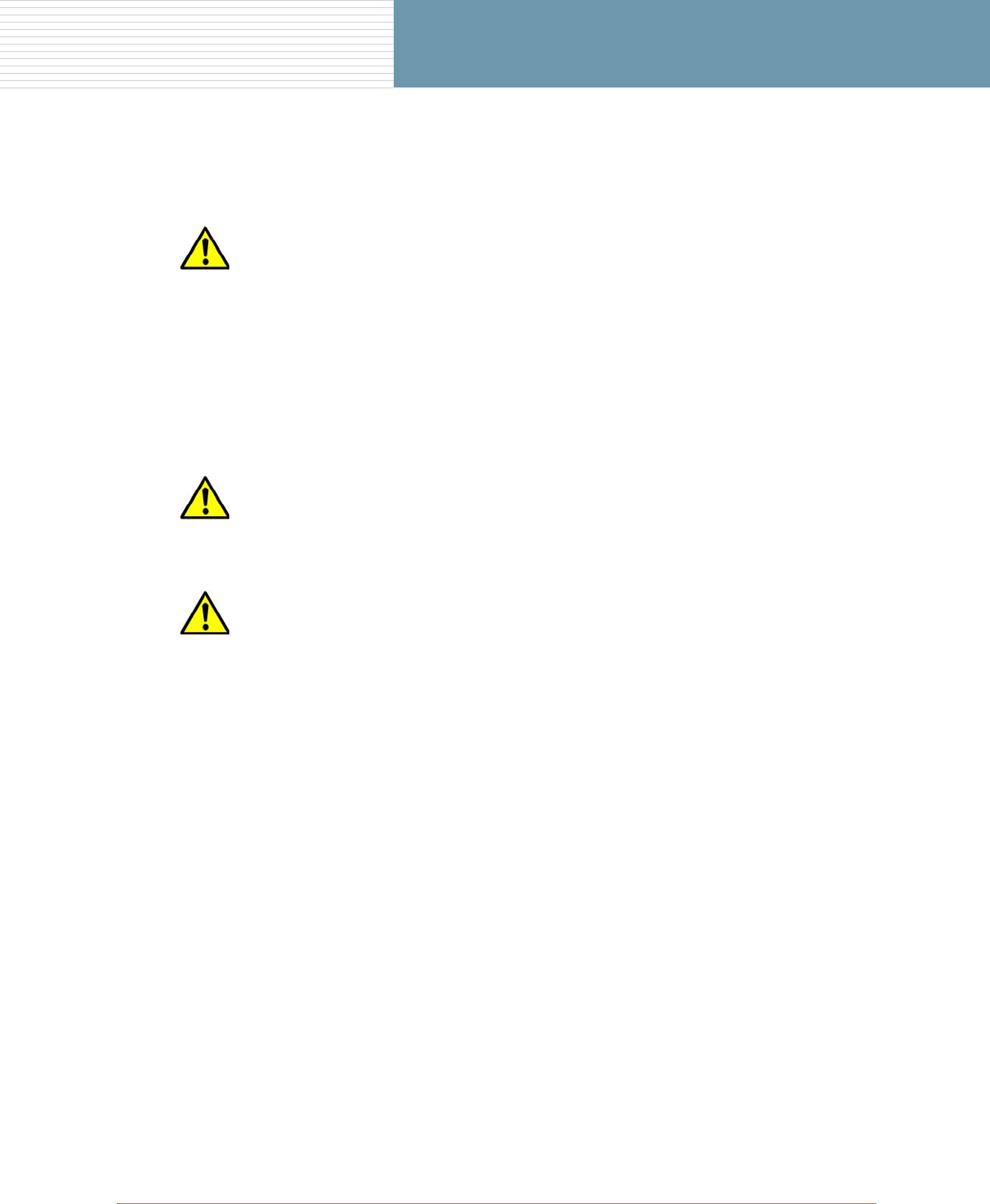
OWS Field Installation 7
OWS Hardware Installation
Antenna Installation
This section provides instructions for installing and connecting antennas.
Antenna Warning
Caution
Caution
Recommended Antennas
Strix recommends the following antenna configurations:
◗One 802.11 omni antenna and one 802.11b/g omni antenna, directly connected to the OWS
enclosure. The remaining unused antenna ports must be terminated with a 50 ohm terminator.
◗Three 802.11b/g 120 degree sector antennas attached to the pole above the OWS enclosure, and up to
three directional 802.11a antennas for fixed point-to-point backhaul connections with other Strix
Systems Access/One® Network devices.
Antennas must be installed by a trained professional installer only.
Do not locate any antenna near overhead power lines or other electric light or power
circuits, or where the antenna can come into contact with such circuits. When
installing antennas, take extreme care not to come into contact with such electrical
circuits, as they can cause serious injury or death.
For the correct installation and grounding of antennas, please refer to national and local
codes (for example, US:NFPA 70, National Electrical Code, Article 810; in Canada:
Canadian Electrical Code, Section 54).
Do not apply power to the transmitter until the antenna is connected, otherwise
permanent damage may result.
When the unit is operation, avoid standing directly in front of the antenna. Strong RF
fields are present when the transmitter is ON.

8OWS Field Installation
OWS Hardware Installation
Notes About Antenna Installation
Read the following notes before installing any antenna.
◗The system installer should always ensure that antenna radiation patterns do not overlap.
◗A sector antenna should point towards the center of the sector covered by the antenna.
◗Fixed point-to-point backhaul antennas should point towards the desired Strix Systems Access/One®
Network device intended for the backhaul connection.
◗Unused antenna ports must be terminated with a 50 ohm terminator.
◗Only Strix Systems antennas may be used with the Access/One® Network OWS 3600.
◗Only one antenna may be used on each antenna port.
◗Depending on the selected antenna(s) for your application, it may be necessary to configure the output
power of your OWS 3600. Please refer to the Access/One Network User’s Guide for details on
configuring output power. It is the installer’s responsibility to ensure the output power is set correctly
for the chosen antenna(s). Operation of the OWS 3600 in a manner other than as represented here is a
violation of FCC rules.
The following are the maximum power settings for each antenna type:
Maximum Power Settings by Antenna / Band
Antenna 2.4 GHz 5.25 - 5.35 GHz 5.725 - 5.85 GHz
12 dBi Omni (2.4 GHz) Full N/A N/A
16.4 dBi Sector Full N/A N/A
12 dBi Omni (5.15 - 5.85 GHz) N/A Quarter (-6 dBm) Full
23 dBi Directional N/A Minimum (0 dBm) Full
29 dBi Parabolic Reflector N/A Minimum (0 dB)m Full
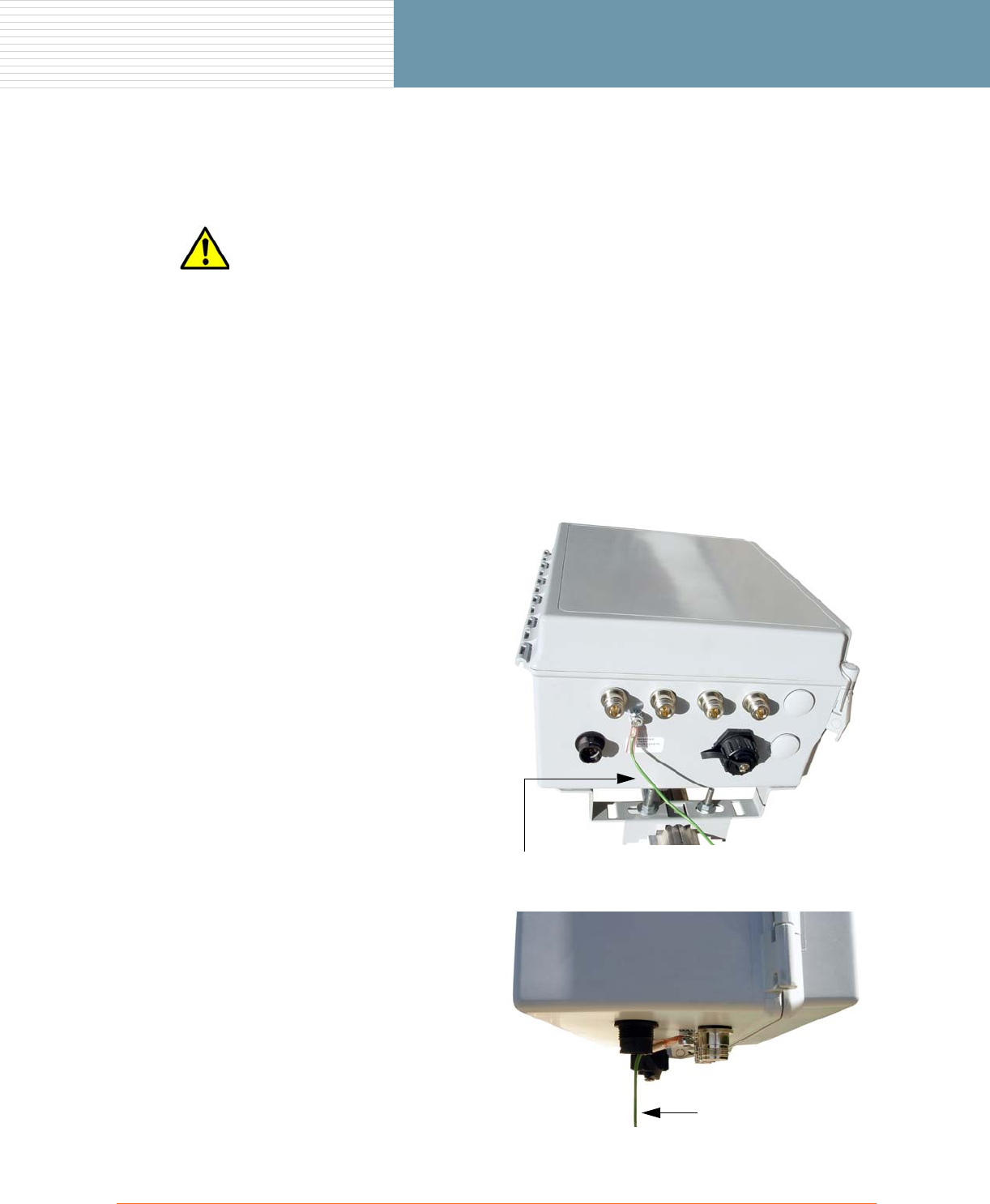
OWS Field Installation 9
OWS Hardware Installation
Grounding the OWS Enclosure
This section provides instructions for grounding the OWS enclosure.
Grounding Caution
Parts Required
◗Ground wire assembly (with ring terminator)—must be 18 gauge AWG wire, or greater
Tools Required
You must ALWAYS install an external grounding wire. The ground connection must be
complete before connecting power to the OWS enclosure—a simple continuity check
between the enclosure and the ground termination point can confirm this. Grounding of
the OWS must comply with National Electrical Code (NEC) requirements, unless local
codes in your area take precedence over the NEC code.
◗3/16 inch nut wrench ◗Wire stripper (if necessary)
1. Connect the ground wire to the
ground terminal on the bottom of
the OWS enclosure.
Make sure the lock washer is in
place and that the nut is securely
fastened.
2. Connect the other end of the
ground wire to a grounding strap
attached to a grounded surface,
such as a cold water pipe (or
other suitable ground termination
point, compliant with NEC and
local standards).
On pole-mounted OWS
enclosures, if the pole (or pole
stand) is already grounded, you
may use one of these items as the
ground termination point.
Ground Wire
Connect to a
suitable ground
termination
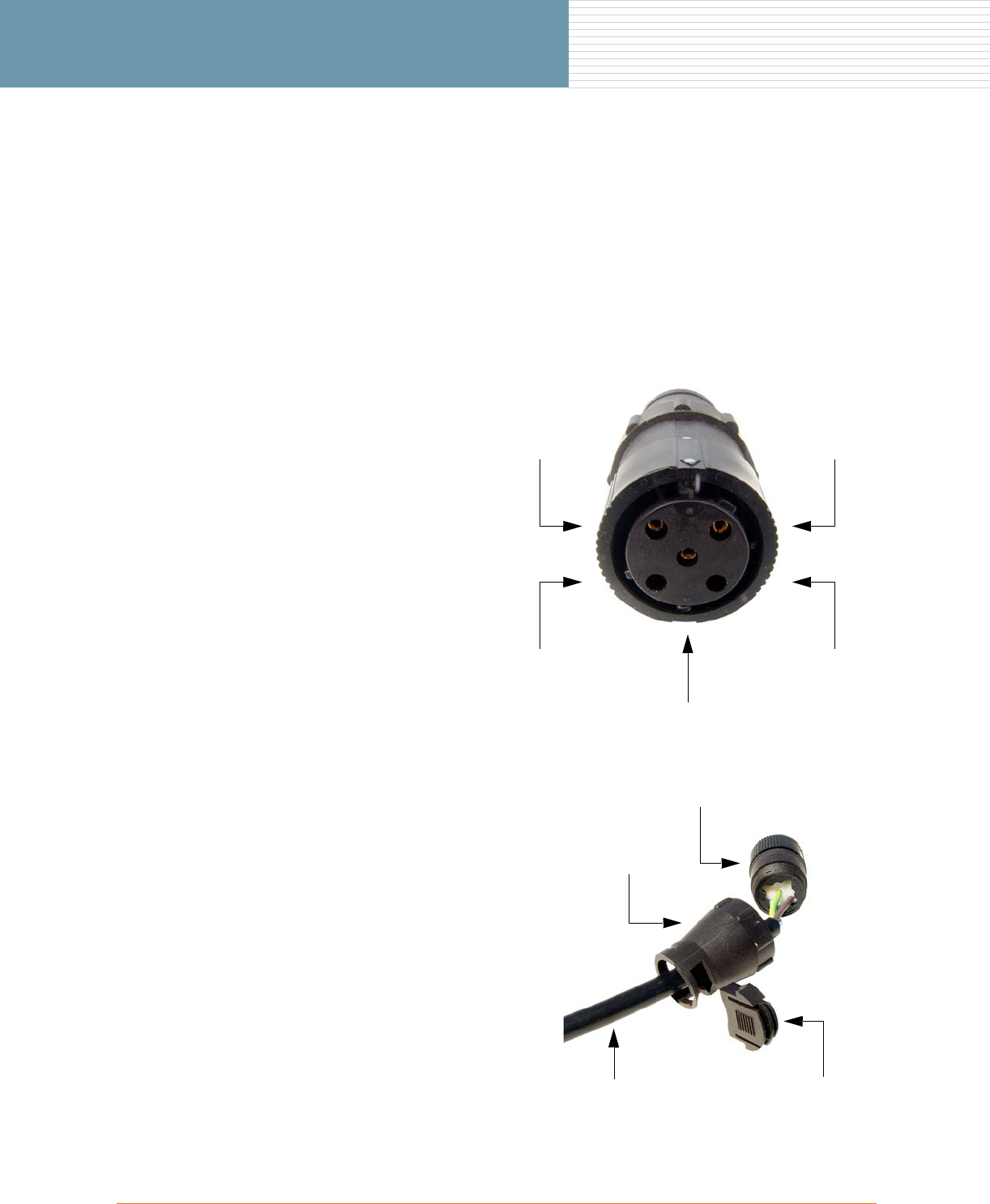
10 OWS Field Installation
OWS Hardware Installation
Connecting the Power Cord
This section provides instructions for configuring the power cord for either AC or DC operation, and
connecting the power cord to the OWS enclosure.
Parts Required
◗AC or DC power cord, cut to the desired length (not supplied)
◗AC/DC plug assembly
Tools Required
◗Wire stripper
1. Review the pin connections.
◗Pin 1 – AC Line
◗Pin 2 – AC Neutral
◗Pin 3 – Ground
◗Pin 4 – DC Negative (–)
◗Pin 5 – DC Positive (+)
2. Assemble the plug and connect
the plug to the power cord for the
electrical configuration you
need, either AC or DC.
Pin 1Pin 2
Pin 4Pin 5
Pin 3
Plug
Shield
Locking Tab
AC example shown
Power Cord
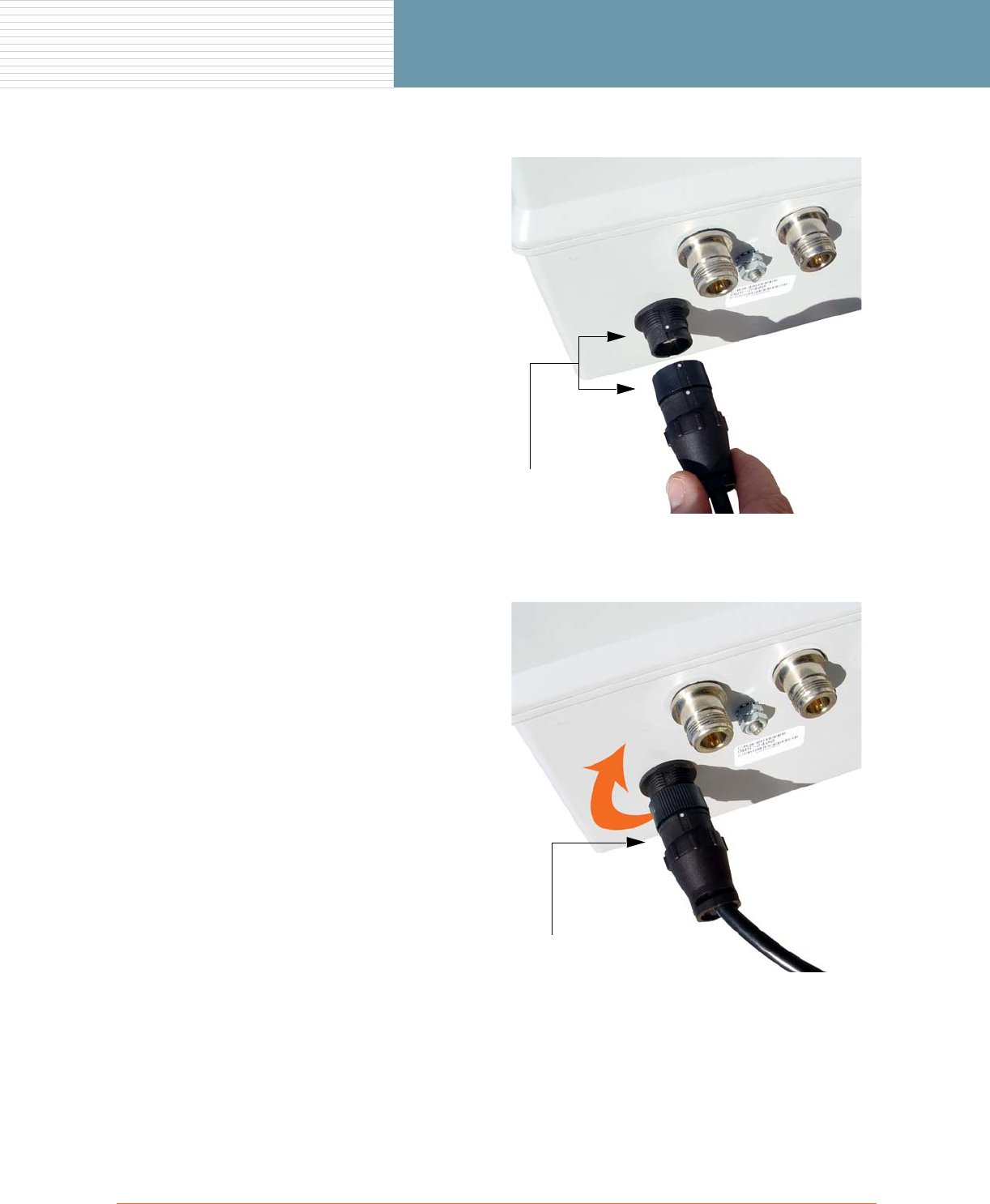
OWS Field Installation 11
OWS Hardware Installation
3. Align the white dots on the plug
and the enclosure’s power
receptacle.
4. Turn the collar of the plug
clockwise (1/4 turn) to make the
connection.
The connection is locked when
you feel and hear a click.
5. Install an appropriate AC or DC
connector at the other end of the
power cord.
The connector you use at the
other end of the power cord
depends on the power source
you are connecting to.
Align the white dots
1/4 turn clockwise to engage
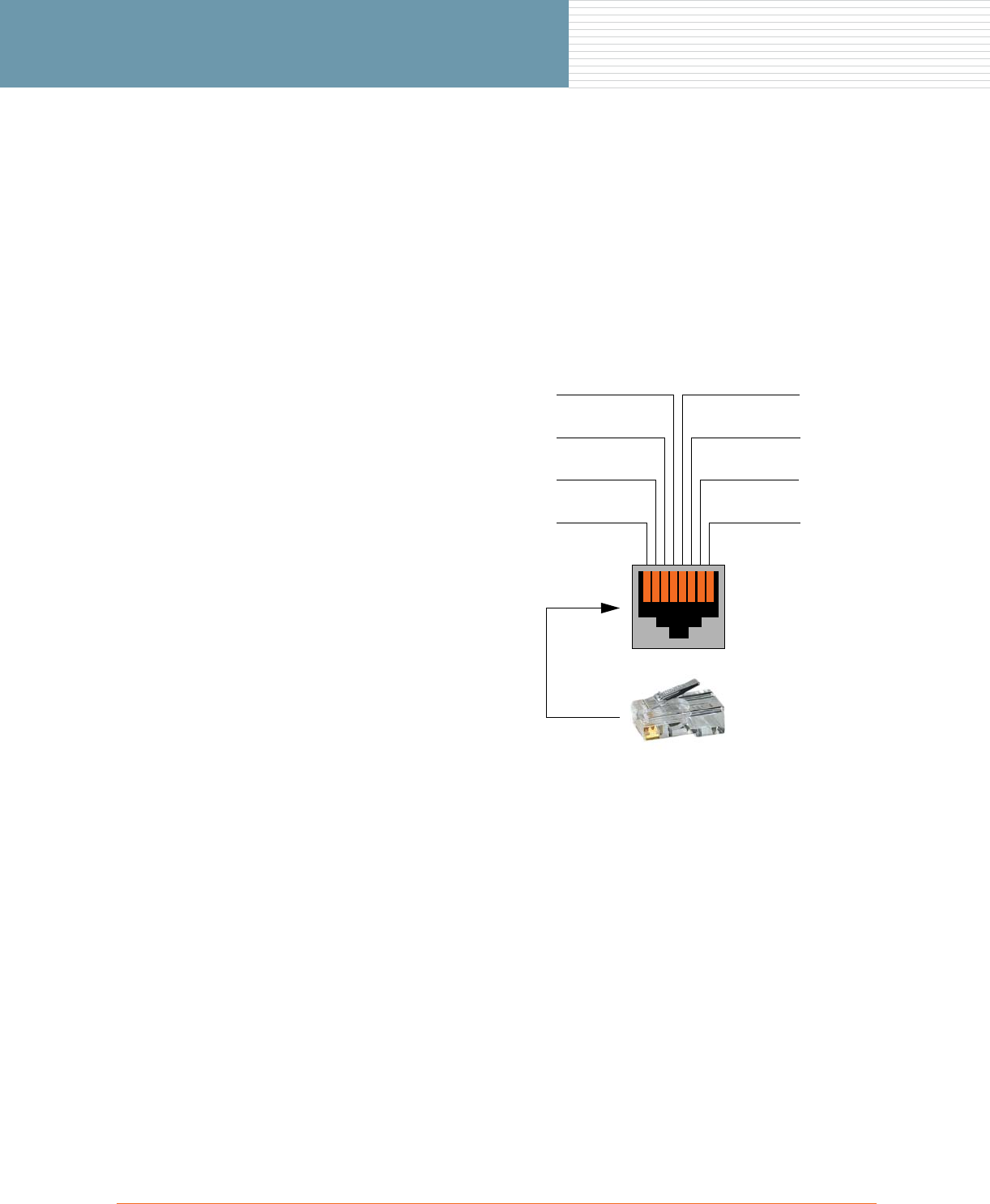
12 OWS Field Installation
OWS Hardware Installation
Connecting the Ethernet Cable
This section provides instructions for configuring the CAT5 Ethernet cable.
Parts Required
◗Plenum-rated CAT5 Ethernet cable, cut to the desired length (not supplied)
◗RJ45 plug assembly
Tools Required
◗Wire stripper ◗Continuity checker
1. Review the pin connections.
◗Pin 1 – TXD+ (TX Data)
◗Pin 2 – TXD- (TX Data)
◗Pin 3 – RXD+ (RX Data)
◗Pin 4 – Not used
◗Pin 5 – Not used
◗Pin 6 – RXD- (RX Data)
◗Pin 7 – Not used
◗Pin 8 – Not used
Pin 1 Pin 8
Pin 2
Pin 3
Pin 4
Pin 7
Pin 6
Pin 5
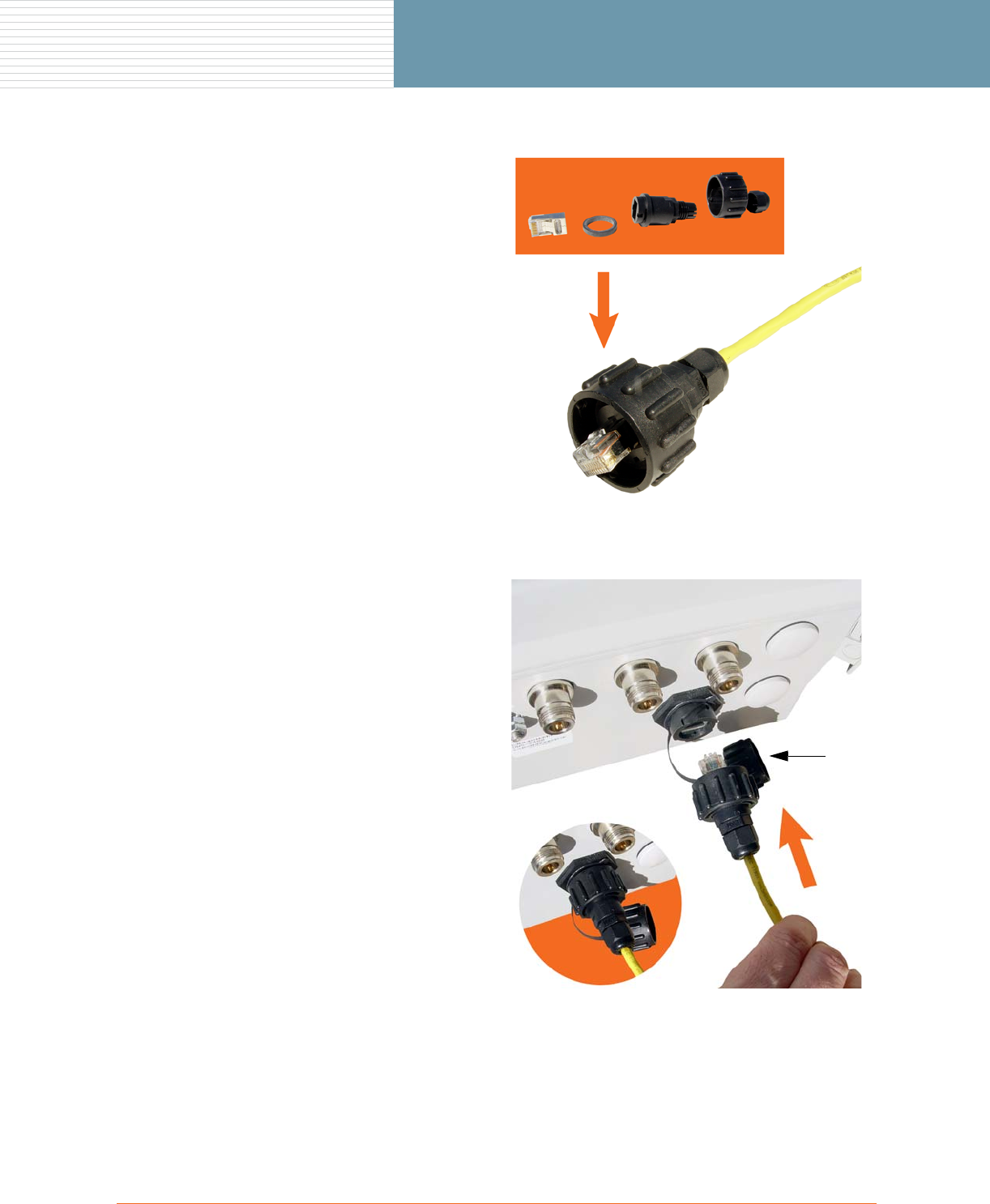
OWS Field Installation 13
OWS Hardware Installation
2. Assemble the RJ45 plug/cable.
◗Item 1 – Shielded RJ45 plug
◗Item 2 – Gasket seal
◗Item 3 – Plug holder
◗Item 4 – Coupling ring
◗Item 5 – Seal assembly
When assembling the plug, take
care not to lose the gasket seal
(item 2)—it must be in place
when the assembly is complete.
3. Install an RJ45 plug at the other
end of the cable.
4. Perform a continuity check on
each pin to verify that the cable
has been assembled correctly.
5. Unscrew the protective cap, then
connect the Ethernet cable to the
OWS enclosure.
Turn the coupling ring clockwise
(1/4 turn) to make the
connection.
The connection is locked when
you feel and hear a click.
12
3
45
Cap
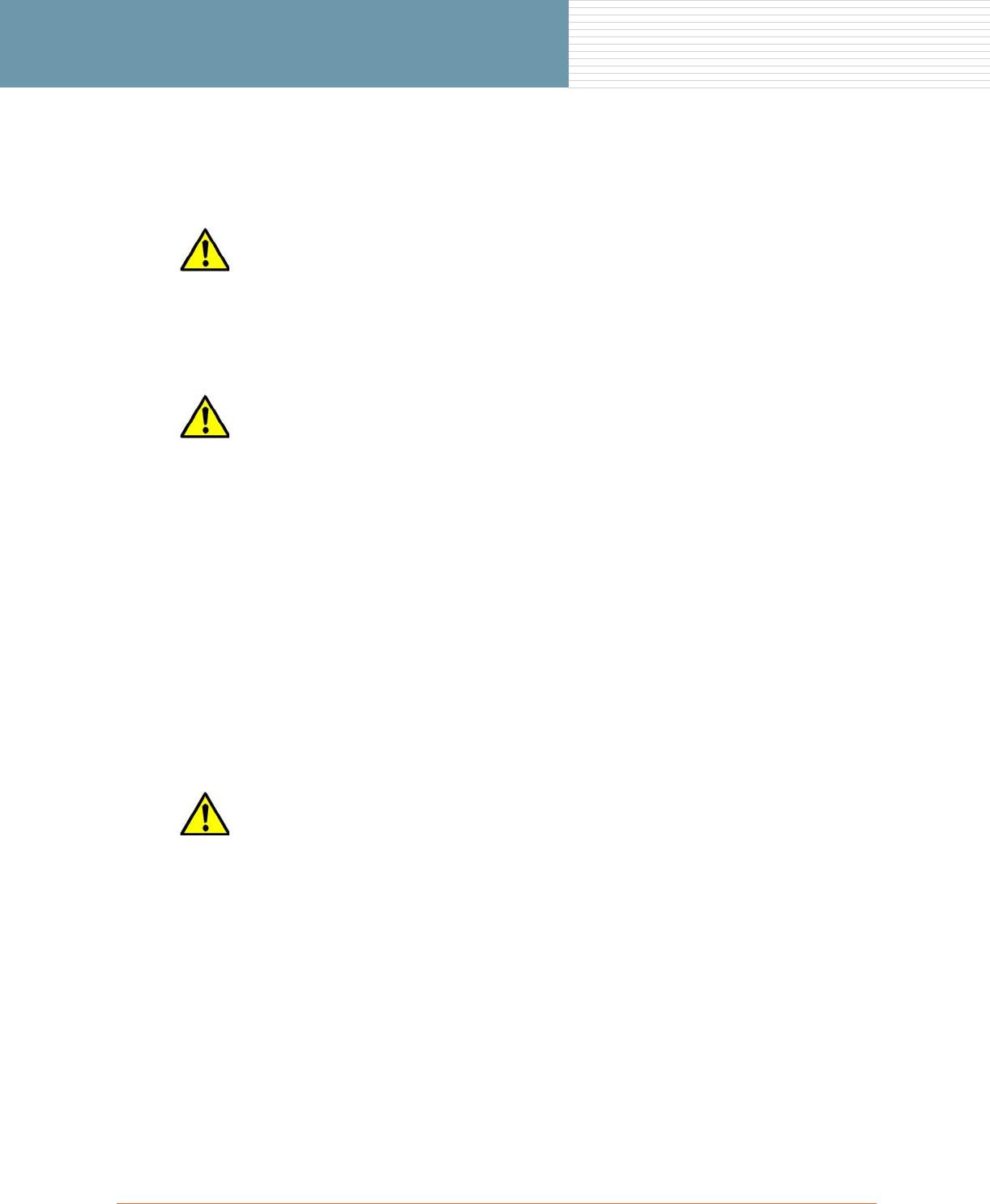
14 OWS Field Installation
OWS Hardware Installation
Powering Up the OWS
This section provides instructions for powering up the OWS from both an AC and DC power source.
Safety Warning
Powering Up from an AC Power Source
Important Note (AC Power)
1. Verify that the AC service voltage is 120 VAC to 240 VAC.
2. Check that the power is turned OFF at the designated circuits.
3. If necessary, install 1/2 inch liquid-tight conduit from the power source to within 3 feet of the OWS.
4. Connect the conduit to a junction box. The conduit and junction box must be IEEE/ANSI compliant
and suitable for outdoor use.
5. Turn ON the Strix OWS and verify that the unit is functioning.
Powering Up from a DC Power Source
Important Note (DC Power)
1. Verify that the DC service voltage is 12 VDC to 24 VDC.
2. Check that the power is turned OFF at the designated circuits.
3. If necessary, install 1/2 inch liquid-tight conduit from the power source to within 3 feet of the OWS.
4. Connect the conduit to a junction box. The conduit and junction box must be IEEE/ANSI compliant
and suitable for outdoor use.
5. Turn ON the Strix OWS and verify that the unit is functioning.
The OWS must be grounded, and the door of the OWS enclosure must always be closed
before applying power to the unit.
AC input: 100 – 240 VAC (50/60 Hz) at 1.0 Amp maximum, supplied by a separate
branch circuit with 2 Amp over-current protection (2 Amp circuit breaker).
The OWS must always be grounded before applying power to the unit—see “Grounding
the OWS Enclosure” on page 9.
DC input: 12 – 24 VDC at 9.0 Amp maximum, supplied by an external separate 250 VA
power-limited (or less) and isolated DC source with 15 Amp over-current protection (15
Amp circuit breaker).
The OWS must always be grounded before applying power to the unit—see “Grounding
the OWS Enclosure” on page 9.

OWS Field Installation 15
OWS Hardware Installation
OWS Product Specifications
WIRELESS
◗Wireless Standards: IEEE 802.11a/b/g
◗Frequency Bands:
802.11a
- 5.25 - 5.35 GHz
- 5.725 - 5.850 GHz
802.11b/g
- 2.4 - 2.4835 GHz (Americas, FCC)
◗Data Rates (Mbps):
- 6, 9, 12, 18, 24, 36, 48, 54 (802.11a/b/g)
- 12, 18, 24, 36, 48, 72, 96, 108 (802.11a Turbo)
◗Wireless Medium:
802.11a – OFDM, 802.11b/g – DSSS
◗Modulation:
- 802.11a: BPSK, QPSK, 16 QAM, 64 QAM
- 802.11b/g: DBPSK, DQPSK, CCK
◗Operating Channels:
802.11a
- 12 (Americas, FCC), includes 3 turbo channels
802.11b/g
- 11 (Americas, FCC)
◗Transmit Power:
Configuration dependent—contact Strix
◗Receiver Sensitivity:
Configuration dependent—contact Strix
◗LO (crystal) Frequency Stability:
+/-10PPM within normal op. range of 0° to 55°C
ELECTRICAL
◗Power Input:
Auto-sensing 120/240 VAC, 50/60 Hz, single
phase, with ANSI/IEEE C62.41 category C3
integrated branch circuit protection
◗AC Power Consumption:
25W typical, 90W maximum
◗DC Input:
12/24V, 9A maximum
PROTECTION CIRCUITS
◗Antenna Lightning Protection (optional):
< 9µJ for 6kV/3kA @ 8/20µs waveform
◗Electrical Protection:
ANSI/IEEE C62.41, UL 1449 2nd edition; 10kA @
8/20 µs waveform, 36kA per phase; L-L, L-N, L-PE
◗Data Protection:
EN61000-4-2 Level 4 ESD Immunity
EN61000-4-5 Level 4 AC Surge Immunity
EN61000-4-4 Level 4 Elect. Fast Transient Burst
Immun.
EN61000-4-3 EMV Field Immunity
ENVIRONMENTAL
◗Operating Temperature: -30°C to +55°C
◗Storage Temperature: -45°C to +85°C
◗Humidity: 10% to 90% non-condensing
◗Weather Rating: IP67 weather tight
◗Wind Survivability: <165 mph
◗Wind Loading (165 mph): <1024 newtons
◗Salt/Fog/Rust Resistance: Mil-STD-810F 509.4
◗Shock & Vibration:
ESTI 300-192-4 spec T41.E
Class 4M3 and Mil-STD-810
◗Transportation: ISTA 2A and Mil-STD-810
PHYSICAL
◗Dimensions:
3600 Series: 14” high x 12” wide x 8” deep (without
accessories)
2400 Series: 12” high x 10” wide x 6” deep (without
accessories)
◗Weight:
3600 Series: 16.5lbs (7.48 Kg)
2400 Series: 14.5lbs (6.58 Kg)
◗NEMA 4 rated for outdoor enclosures
SECURITY
◗Authentication:
802.1x support, including RADIUS client, EAP-MD5,
EAP-TLS, and PEAP-TTLS, WPA
◗Encryption:
IEEE 802.11i (WPA2) with AES, and WEP
REMOTE MANAGEMENT
◗Web, CLI and SNMP interfaces
◗Supports BOOTP, DHCP, Telnet, SSH, HTTP, HTTPs, and
FTP
◗SNMP: MIB II, 802.11 MIB, and Strix private MIBs
APPROVALS
◗FCC CFR47 Part 15, Class B
◗Industry Canada RSS210
◗EN60950 cTUVus Listed I.T.E
◗UL 579/IEC 60529 IP67, rated for outdoor use
◗UL 1449 2nd edition / IEC 60664-1
◗CAN/CSA-C22.2 60950-00
◗VCCI Class B
WARRANTY
◗One year parts and labor

16 OWS Field Installation
OWS Hardware Installation

17
OWS Hardware Installation
Index
A
AC power 14
adapter 7
airplanes
use in 1
antenna
recommended 7
antenna adapter 7
antennas
placement 2
type 2
B
building codes 2
building materials 2
C
CAT5 cable 12
connector 10
contact information i
continuity check 13
copyright notice i, ii
coupling 13
D
data rates 2
DC power 14
directional antenna 7
E
environmental limits 1
Ethernet cable 12
European Community (EC) conformity ii
explosive device proximity iii
F
FAA 1
FCC notice ii
Federal Aviation Administration 1
G
gasket seal 13
ground termination 9
grounding 9
H
hazardous locations 1
hospitals
use in 1
I
Industry Canada notice ii
L
local guidelines 2
M
mounting 3
antennas 7
brackets 3
N
NEC code 2, 9, 12
non-modification statement iii
notices ii
European Community (EC) ii
FCC ii
Industry Canada ii
VCCI ii
O
obstructions 2
omni antenna 7
over-current protection 14
OWS 2400 1
OWS 3600 1
P
physical environment 2
planning the installation 2
plug 10
assembly 11
pole 3
power cord 10
power source 2
powering up 14
product specifications 15
R
RF exposure iii
RJ45 plug assembly 13
S
safety information 1
safety warnings iii
site survey 2
specifications 15
straps 3, 6
Strix contact information i
survey 2
